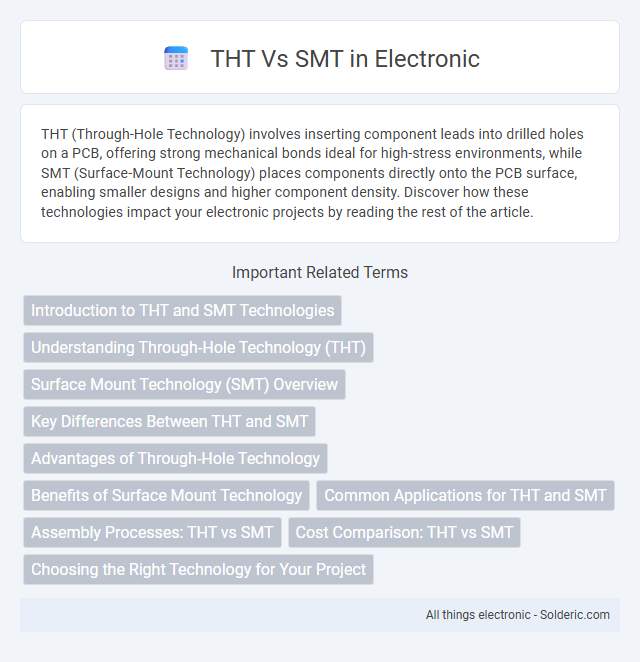THT (Through-Hole Technology) involves inserting component leads into drilled holes on a PCB, offering strong mechanical bonds ideal for high-stress environments, while SMT (Surface-Mount Technology) places components directly onto the PCB surface, enabling smaller designs and higher component density. Discover how these technologies impact your electronic projects by reading the rest of the article.
Comparison Table
| Feature | THT (Through-Hole Technology) | SMT (Surface-Mount Technology) |
|---|---|---|
| Mounting Method | Component leads inserted in drilled holes | Components soldered directly on PCB surface |
| Component Size | Larger, bulkier components | Smaller, compact components |
| Assembly Speed | Slower, manual or selective soldering | Faster, automated pick-and-place machines |
| Mechanical Strength | Stronger mechanical bonds due to lead insertion | Lower mechanical strength, better for light applications |
| Cost | Generally higher due to labor and materials | Lower due to automation and less material use |
| Repair and Prototyping | Easier to handle and debug | More challenging, requires specialized tools |
| Common Applications | High-reliability electronics, military, and aerospace | Consumer electronics, mass production |
Introduction to THT and SMT Technologies
Through-Hole Technology (THT) involves inserting electronic component leads into pre-drilled holes on a printed circuit board (PCB) and soldering them on the opposite side for strong mechanical bonds, commonly used for components requiring durability and high power handling. Surface-Mount Technology (SMT) places components directly onto the PCB surface without drilling holes, enabling smaller, lighter assemblies with higher circuit densities by using solder paste and reflow soldering techniques. SMT supports automated manufacturing with increased production speed and reduced cost, becoming the dominant method in modern electronics assembly compared to the more traditional THT approach.
Understanding Through-Hole Technology (THT)
Through-Hole Technology (THT) involves inserting component leads into drilled holes on a printed circuit board (PCB) and soldering them on the opposite side, providing strong mechanical bonds ideal for heavy or high-stress components. This method enhances durability and reliability, making it suitable for connectors, transformers, and large capacitors in industrial and military applications. Understanding the placement and soldering techniques of THT components ensures your electronic assemblies withstand physical and thermal stress effectively.
Surface Mount Technology (SMT) Overview
Surface Mount Technology (SMT) revolutionizes electronic assembly by allowing components to be directly mounted on the PCB surface, enabling higher component density and smaller board sizes. SMT components are typically smaller and lighter than Through-Hole Technology (THT) parts, which enhances manufacturing speed and reliability. By choosing SMT, you benefit from improved electrical performance and automated production efficiency.
Key Differences Between THT and SMT
Through-Hole Technology (THT) involves inserting component leads into drilled holes on a printed circuit board (PCB), providing strong mechanical bonds suitable for high-stress applications. Surface-Mount Technology (SMT) attaches components directly onto the PCB surface, enabling higher component density, improved electrical performance, and more efficient automated assembly. THT is preferred for heavy or large components, while SMT supports faster production and miniaturization in modern electronics.
Advantages of Through-Hole Technology
Through-Hole Technology (THT) provides superior mechanical strength and durability, making it ideal for components subjected to high stress or thermal cycling. It facilitates easier prototyping and manual soldering, which benefits repairability and modification processes in complex circuits. THT's robust connections ensure reliable performance in heavy-duty applications and high-voltage environments where Surface-Mount Technology (SMT) might be less effective.
Benefits of Surface Mount Technology
Surface Mount Technology (SMT) offers significant benefits such as higher component density, enabling more compact and lightweight electronic devices by placing components directly onto the PCB surface. SMT improves manufacturing efficiency through faster assembly processes and supports automated mass production, reducing labor costs and increasing yield. Your designs benefit from better electrical performance and reliability due to shorter lead lengths and lower parasitic inductance compared to Through-Hole Technology (THT).
Common Applications for THT and SMT
THT (Through-Hole Technology) is commonly used in applications requiring strong mechanical bonds, such as automotive electronics, military equipment, and industrial machinery, where durability and reliability under harsh conditions are crucial. SMT (Surface-Mount Technology) dominates consumer electronics, telecommunications, and high-speed computing hardware due to its compact size, higher component density, and automated assembly benefits. Your choice between THT and SMT depends on factors like production volume, performance needs, and space constraints.
Assembly Processes: THT vs SMT
Through-Hole Technology (THT) assembly involves inserting component leads through pre-drilled holes on the PCB, requiring manual or automated soldering on the opposite side, which provides strong mechanical bonds suitable for heavy components. Surface-Mount Technology (SMT) assembly places components directly onto the PCB surface pads, enabling automated pick-and-place machines and reflow soldering, resulting in higher production speed and greater component density. SMT is generally preferred for modern electronics due to its efficiency and the ability to support smaller, more complex circuits compared to the bulkier THT process.
Cost Comparison: THT vs SMT
Through-Hole Technology (THT) typically incurs higher production costs due to increased labor intensity and manual assembly processes, whereas Surface-Mount Technology (SMT) benefits from automated placement, reducing labor expenses and enabling mass production efficiency. SMT's compact design allows for smaller PCB sizes, decreasing material usage and associated costs compared to THT's larger footprint requirements. While SMT generally offers cost advantages for high-volume manufacturing, THT may be more cost-effective for low-volume or prototype runs due to simpler tooling and setup.
Choosing the Right Technology for Your Project
Selecting between Through-Hole Technology (THT) and Surface-Mount Technology (SMT) depends on your project's specific requirements, such as component size, production volume, and mechanical strength. THT offers superior durability and is ideal for prototypes or products needing manual assembly, while SMT supports higher component density and faster automated manufacturing processes. Evaluating factors like cost-efficiency, soldering methods, and device lifespan helps ensure you choose the optimal technology for your electronic assembly.
THT vs SMT Infographic

 solderic.com
solderic.com